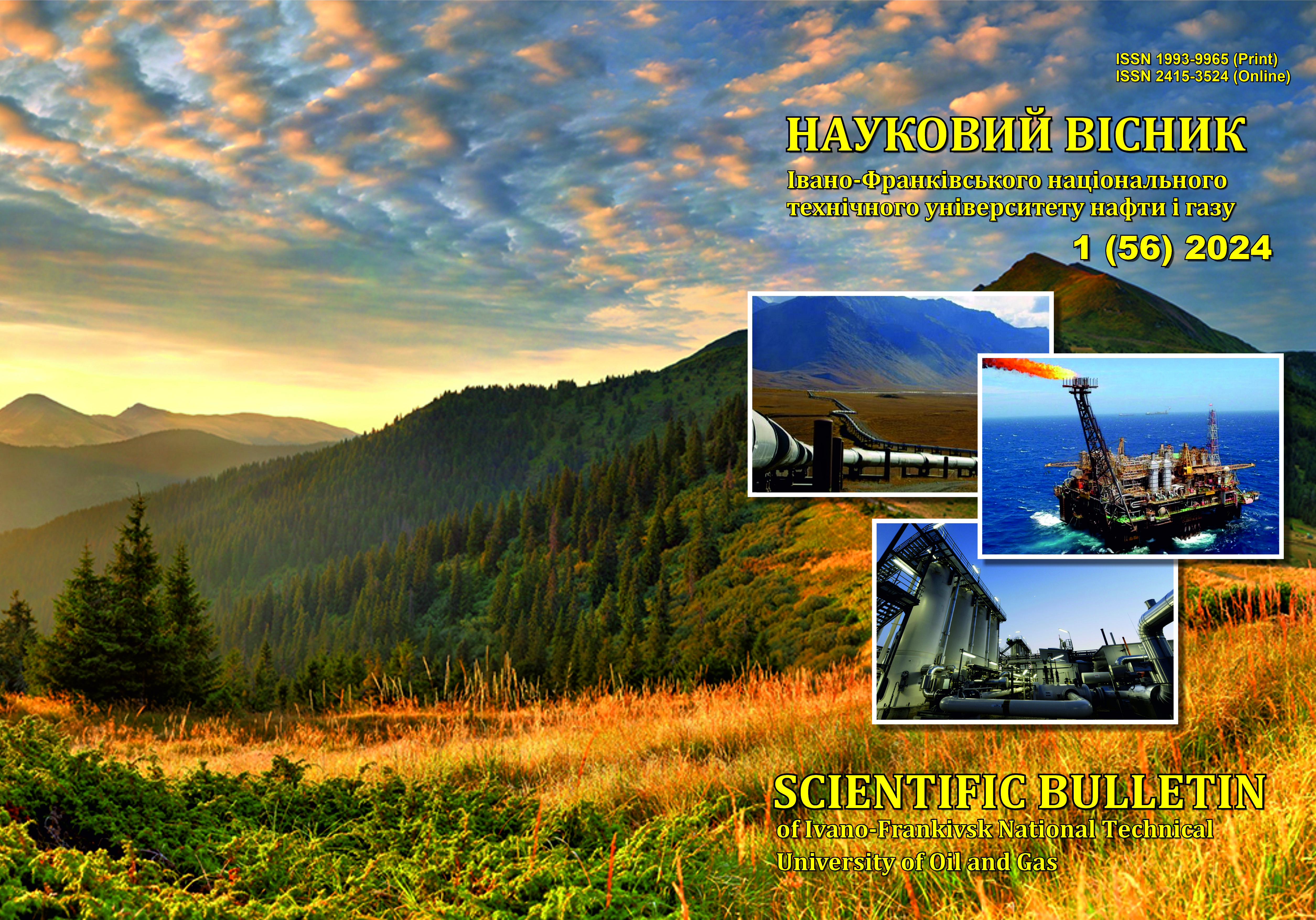SELECTION OF A RATIONAL SCHEME FOR THE USE OF AN OIL JET PUMP
DOI:
https://doi.org/10.31471/1993-9965-2024-1(56)-60-67Keywords:
ejection system, downhole jet pump, ejection coefficient, relative pressure, energy characteristic, cavitation.Abstract
The hydraulic characteristics are determined and their comparative analysis is performed for the two most common schemes of using an oil jet pump in a well: forward and reverse circulation ejection systems. In a forward circulation ejection system, the working fluid generated by the surface pumping unit is directed to the tubing string and the well fluid is lifted through the intertubing space. In a reverse-circulation production system, the working fluid flows through the intertubular space channel to the working nozzle of the jet pump, and the formation fluid is transported by a column of tubing. In the process of modeling the working process of the ejection system, the equation of the hydraulic system of the jet pump was obtained, which includes the value of hydrostatic and formation pressures and the value of hydraulic losses in the elements of the pumping and circulation system of the well. The pressure losses in the pressure line of an oil jet pump in the case of forward and reverse circulation of the working medium are determined in the channels of the inter-tube space and the lifting column, respectively, and include a preliminary calculation of the flow rate, its mode of movement and linear hydraulic resistance coefficients. The use of an ejection system with direct circulation of the working medium allows increasing the ejection coefficient by 40.5 % and the efficiency by 28.6 %. The study of cavitation characteristics has shown that the ejection system with direct circulation of the working medium is characterized by an increased probability of cavitation in the flow part of the jet pump. The danger of the jet pump operation in the cavitation mode increases with an increase in the required flow rate of the working fluid, which is typical when using ejection systems for high-rate wells. In addition, the lifting of well products, especially in the presence of aggressive substances and mechanical impurities, through the intertubular channel of the production string contributes to the violation of its tightness. Taking into account the results of the conducted studies, the use of a scheme for placing a jet pump with reverse circulation of the working medium in the well can be recommended in the presence of aggressive substances and high sand content in the formation fluid, as well as in the operation of high-rate wells.
Downloads
References
Wyrostkiewicz M., Panevnyk D.A. Simulation of the working process of a dual-circuit downhole ejection system. Nafta-Gaz. 2022. No. 9. P. 654–661. https://doi.org/10.18668/NG.2022.09.02.
Panevnyk D.A. Simulation of a downhole jet-vortex pump’s working process. Nafta-Gaz. 2021. No. 9. P. 579–586. https://doi.org/10.18668/NG.2021.09.02.
Pandya S., Ahmed R., Shah S.N. Experimental study on wellbore cleanout in horizontal wells. Journal of Petroleum Science and Engineering. 2019. Vol. 177. Iss. 6. P. 466-478. https://doi.org/10.1016/j.petrol.2019.02.069.
Vélez R.P., Vásquez-Santacruz J., Marín-Urías L.,Vargas A., García-Ramírez P., Morales-de-la-Mora J., Vite-Morales A., Gutierrez-Domín-guez E. Efficiency Maximization of a Jet Pump for an Hydraulic Artificial Lift System. Revista Internacional de Métodos Numéricos para Cálculo y Diseño en Ingeniería. 2019. Vol. 35. Iss. 1. 13 p. https://doi.org/10.23967/j.rimni.2018.11.002.
Chavan C., Jha M., Singh M.K., Singh R. Selection and Successful Application of Jet Pumps in Mangala Oil field: ACase Study. SPE Artificial Lift Conference and Exhibition held in Manama, Bahrain, 27-28 November 2012. SPE 163116. 24 p. https://doi.org/10.2118/163116-MS.
Panevnyk D., Kreheľ R. Investigation of the characteristics of an oil jet pump when using a group ground drive. Journal of Engineering Research. 2023. Vol. 11. Iss. 1. March 2023. Article 100004. 6 p. https://doi.org/10.1016/j.jer.2023.100004.
Hakiki F., Wibowo A.T., Rahmawati S.D., Yasutra A. An Analytical Model for Multilayer Well Production Evaluation to Overcome Cross-Flow Problem. SPE/IATMI Asia Pacific Oil & Gas Conference and Exhibition, Bali, Indonesia, 17–19 October 2017. SPE-186275-MS. 14 p. https://doi.org/10.2118/186275-MS.
Patent USA No US4790376A, Cl. E21B43/129. Downhole jet pump / Weeks B.R. Appl. US06/935,819; filed: 28.11.1986; pub. date: 12.13.1988.
Carvalho P.M., Podio A.L., Sepehrnoori K. An electrical Submersible jet pump for gassy oil wells. Journal of Petroleum Technology. 1999. No 5. Р.34-35. https://doi.org/10.2118/0599-0034-jpt.
Wang Z., Lei Yu., Wu Z., Wu J., Zhang M., Liao R. Structure Size Optimization and Internal Flow Field Analysis of a New Jet Pump Based on the Taguchi Method and Numerical Simulation. Processes. 2023. Vol. 11. Iss. 341. https://doi.org/10.3390/pr11020341.
Nunez Pino O.A., Pugh T.S., Hubbard J. Gas Lift-Jet Pump Hybrid Completion Reduces Nonproductive Time During Unconventional Well Production. SPE Argentina Exploration and Production of Unconventional Resources Symposium, Buenos Aires, Argentina,1–3 June 2016. SPE-180958-MS. 9 p.
Panevnyk D.O. Metod kontroliu kavita-tsiinykh kharakterystyk sverdlovynnoho strumyn-noho nasosa. Metody ta prylady kontroliu yakosti. 2023. No 2 (51). P. 72–80. DOI: 10.31471/1993-9981-2023-2(51)-72-80. [in Ukrainian]
Downloads
Published
How to Cite
Issue
Section
License
Авторські права....


1.png)

















